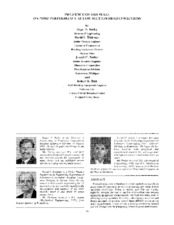| dc.description.abstract | Pressurized gas seal technology has been applied successfully to many types of equipment, in various processes, and under diverse operating conditions. Using a readily available gas supply, typically nitrogen, the seal is capable of providing zero process emissions, no process contamination, and high reliability, even off-design pump operation. Recently, a discrepancy was observed during standard net positive suction head (NPSH) testing at the pump manufacturer. Under certain operating condition, normal gas seal leakage into the pump may influence pump performance. A standard pump NPSH test objective is to vaporize liquid within the impeller and to generate a measurable head loss as a direct result. When a gas seal is used in a pump NPSH test, the total differential head (TDH) is reduced for reasons other than cavitation. Before the liquid’s vapor pressure can be reached, the gas leakage across the seal faces expands and reduces the pump’s TDH by three percent or more. Although the pump test indicates a high NPSHᵣ (the r is for required), in reality, the pump never reaches the point of cavitation. Based on standard NPSH testing, a test program documented the effect of gas leakage into the pump under varying operating conditions. While operating at both low suction pressure and low pump flowrate conditions, the effects of gas leakage are the most evident. Because these conditions are inherent in standard NPSH tests but much less common in field installations, the relevance of pump NPSH performance data should be evaluated at true conditions. The results of these tests may help pump users and pump suppliers understand the effects of gas leakage into the pump. Pump and seal operating guidelines are outlined to minimize the influence of gas and to avoid field problems. | en |


